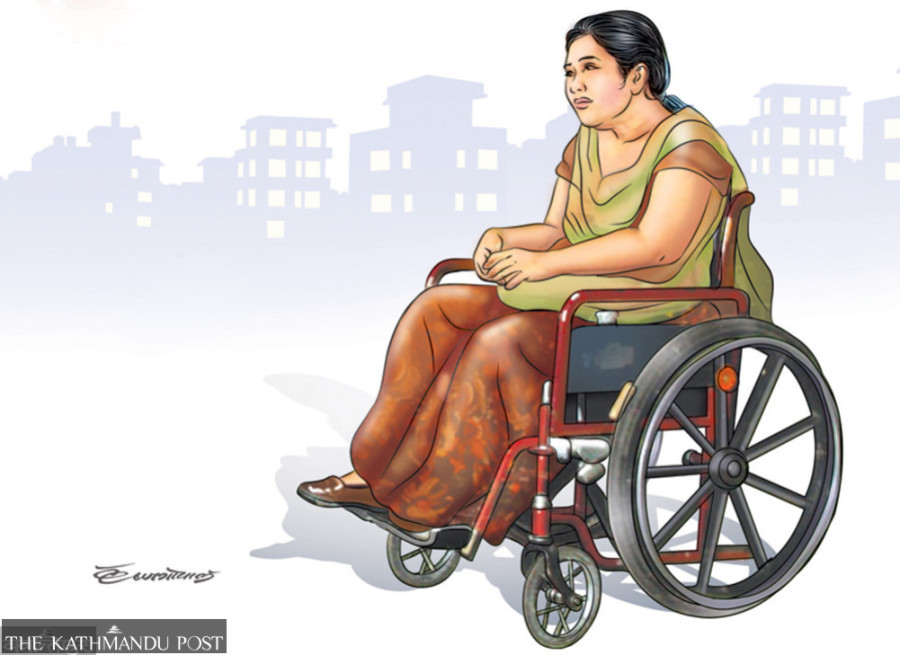Editorial
Leave no one behind
Despite the state’s multiple commitments, our public infrastructures are not disabled-friendly.
Nepalis with disabilities face the daily ordeal of navigating cities that are not built for them. Whenever roads and sidewalks are built or expanded, the disabled community harbours hope of easier mobility. However, the authorities either overlook the accessibility for such people or carelessly build structures that are supposed to assist them. This renders people not only disabled by their conditions but also by infrastructural shortcomings.
According to the National Census 2021, 2.2 percent of Nepal’s population has some form of disability; 2.5 percent of males and 2 percent of females have a disability. The country ratified the Convention on the Rights of Persons with Disabilities and the Optional Protocol to the Convention on the Rights of Persons with Disabilities in December 2009. Moreover, the provisions in the Disability Rights Act ensure accessibility to physical infrastructure. Although Nepal has a progressive policy on the rights of people with disabilities, the implementation part has been lagging. An audit published by the National Federation of the Disabled-Nepal on 150 public infrastructure sites in Kathmandu showed that no samples were completely accessible: 132 samples were found “not accessible”, while the rest were “partially accessible”.
In 2021, the Department of Roads allocated Rs 50 million for disabled-friendly pavements and even completed the first phase, a 1.5km stretch from Putalisadak to Thapathali. Although this is commendable, these supposedly disabled-friendly pavements need routine monitoring, as most of the tactile pavings built earlier ended abruptly or led to electricity poles, trees, walls or drains. Generalising disabilities and offering solutions that only cater to a specific group is also problematic. Most of the time, the authorities build tactile paving and label the area disability-friendly. However, problems of people with other forms of physical and intellectual disability—such as lack of tactile or audio indicators at zebra crossings, narrow sidewalks and absence of ramps—remain unaddressed.
Although road accidents occasionally make headlines, accidents involving people with disabilities rarely get noticed. Many unreported cases involve people with disabilities falling into rivers or drains, collisions with poles or trees due to ineffective tactile blocks, and hit-and-run cases while crossing roads. These accidents can be avoided if basic assistance like railings, ramps, audio and tactile indicators, etc are ensured. In many instances, these problems arise not from the lack of disability-friendly infrastructures but from the general mismanagement and poor condition of public infrastructures. Potholes are a common sight on older roads and even some newer ones in Kathmandu.
With the city’s rapid urbanisation, construction is happening every few metres. Building materials are often placed on sidewalks that are already narrow, leaving pedestrians with no choice but to walk on the roads. This poses a risk for everyone and could be perilous for people with disabilities. Moreover, the roads that seem perfectly fine the previous day are under maintenance the next day. The authorities do not consider providing an alternative disability-friendly route. Even the signs that inform of the situation of the roads ahead are ineffective.
Doing the bare minimum to check the inclusivity list is not an option. Many government office buildings in Nepal are not disability-friendly, and the same applies to institutions like schools and universities. This is also due to the lack of proper budget, as disabled-friendly infrastructures are often not prioritised, depriving a significant and capable portion of the population of their fundamental rights. The government must ensure that people with disabilities have the rights that are promised in the constitution. As for our part as citizens, we must abandon our primitive mindset and be more inclusive of people with disabilities in our thoughts and actions. It’s time we realise that an inclusive nation leaves no one behind as it progresses.




 14.12°C Kathmandu
14.12°C Kathmandu














